Bold, cheerful, summery, and even delicious, sunflowers are a plant that just about everyone recognizes and seems to love.
Unfortunately, pests love them too!
Not to worry, we’ve got everything you need to know about who might visit your sunnies for a nibble, including what they look like, and how you can deal with them.
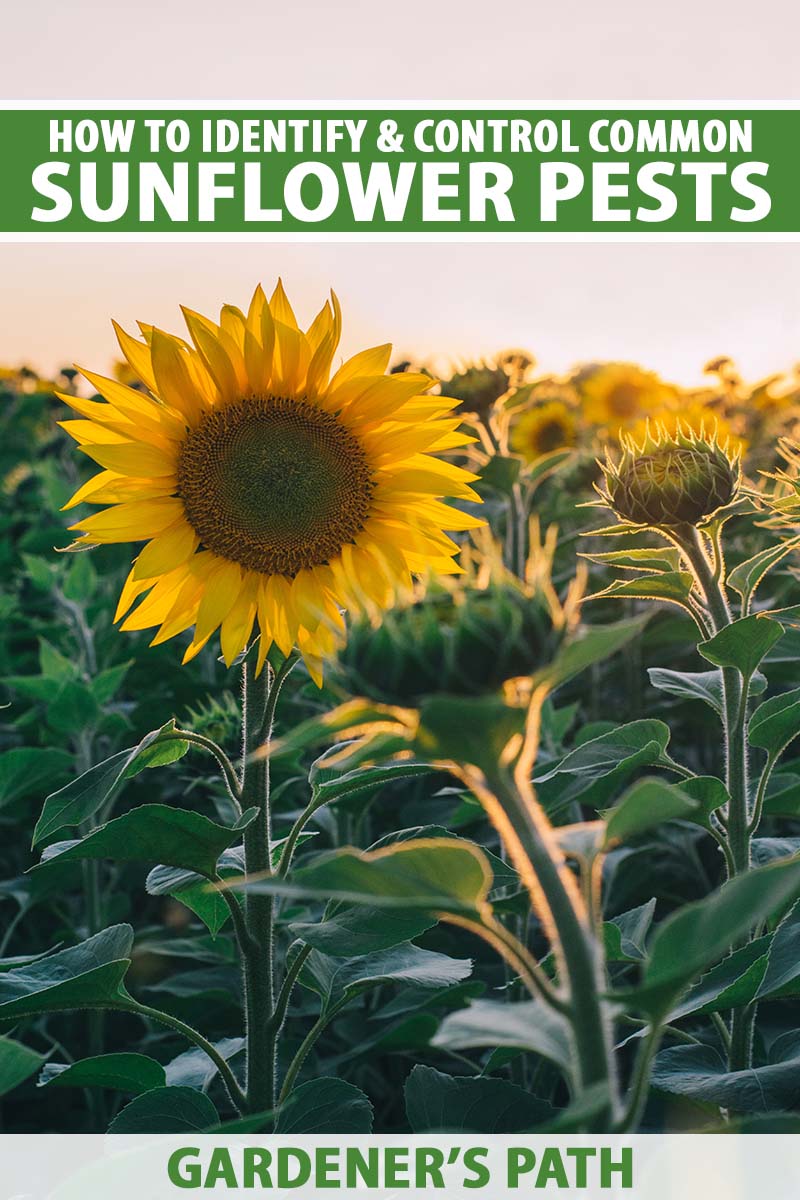
We link to vendors to help you find relevant products. If you buy from one of our links, we may earn a commission.
Here’s what we’ll cover:
How to Identify and Control Sunflower Pests
When to Look for What
The list of pests that like to nibble on Helianthus can be a little daunting, but if we break this up into groups of which insects to watch out for during the different plant development stages, it becomes a lot simpler to understand and plan for.
Seedlings attract cutworms, wireworms, and sunflower beetles.
During the vegetative state, which is when the plant is growing those tall stems and big leaves, keep an eye out for sunflower beetles, thistle caterpillars, and stem weevils.
And finally, during flowering and seed development, watch for seed and head clipping weevils, maggots, sunflower midges, sunflower moths, and lygus bugs.
Of course, aphids can be a problem at any time.
Keep reading to learn more about each of these pests and how to control them.
Aphids
Like many other plants, Helianthus attracts a variety of aphid types, including the melon, peach, and leaf curling plum aphid.
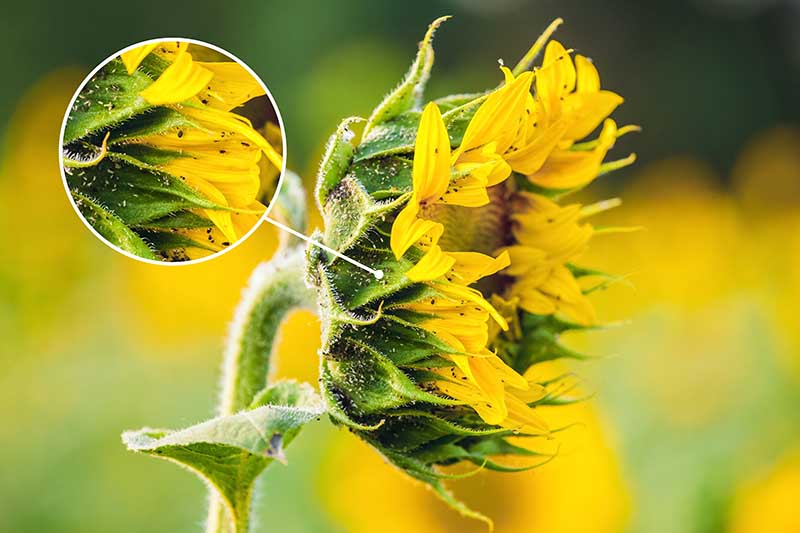
Regardless of the type, aphids are small insects that will suck on leaves, young stems, and flower petals. They also secrete honeydew, which ants and painted lady butterflies like to feed on, and which can develop sooty mold.
Insecticidal soaps, such as this one from Bonide that’s available at Arbico Organics, can be effective against aphids and are safe for pollinators if applied correctly.
Cutworms
There are several species of cutworms that find new sunflower seedlings delicious. In fact, it is recommended to farmers to plant a border of Helianthus around gardens or fields to attract the cutworms away from other crops.
Leaf damage looks like small transparent sections chewed by young larvae, notches, and wilting. But cutworms get their name from their habit of clipping the plant off at the soil line, a very incriminating symptom.
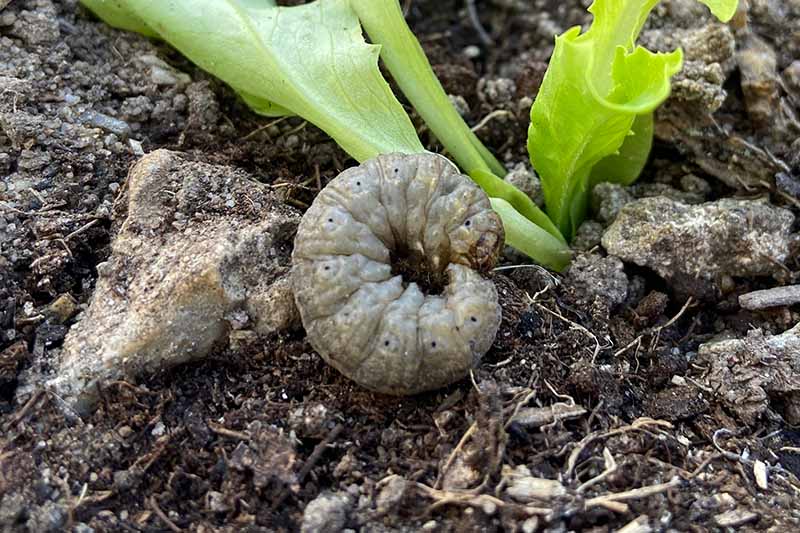
Most cutworms feed at night and hide in the soil a few centimeters from the plant. To find them, gently dig the soil around the plant and look for fat, soft, curled brown or gray larvae.
Preventative options include weed control, as weeds shelter and feed cutworms before your plants are up. In the fall, work up the soil to expose the larvae and pupae to hungry birds. Handpick the larvae at night after watering or a rainfall, or let your chickens do the work for you.
Cutworms love to live in the grass, so leave a three-foot-wide bare soil strip in between your lawn and garden. This makes it harder for the larvae to get to your plants.
Create a homemade barrier around each seedling at planting time. Cut the bottom out of a milk carton and push it two inches into the soil to surround the seedling.
You can also spread a layer of diatomaceous earth around the base of each seedling as a fatal barrier.
Perm-Guard Crawling Insect Control
Try Perm-Guard Crawling Insect Control, available at Arbico Organics.
Beneficial nematodes, especially Steinernema carpocapsae, available at Arbico Organics, will attack the larvae in the ground and are safe for everyone involved, including the bees!
Alternatively, apply a Bacillus thuringiensis product such as Monterey Bt Liquid, available at Arbico Organics. This is another pollinator safe and effective option.
Lygus Bugs
Lygus bugs (Lygus spp.) come in shades of green to red-brown and have a distinctive light-colored triangle at the wing base.
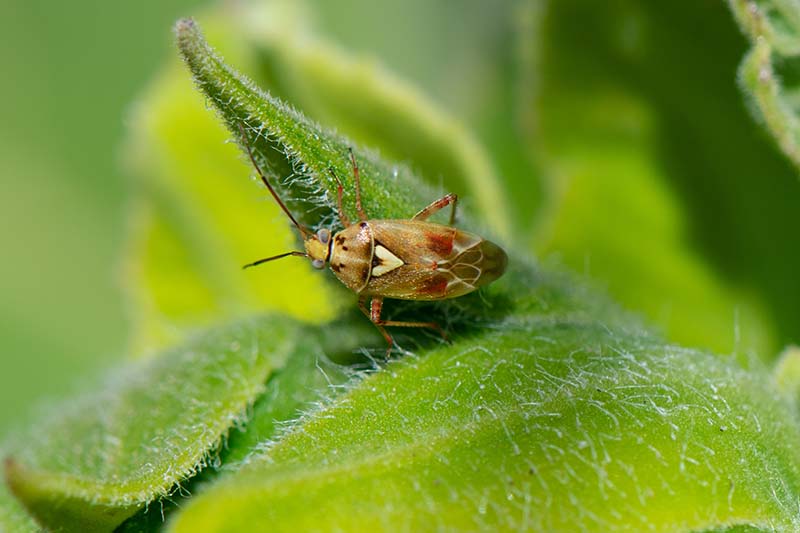
Nymphs are green and look like aphids, but are much faster moving and don’t have the aphid’s characteristic “tailpipes” (cornicles).
Lygus bugs feed by injecting enzymes that digest plant tissues into the plant and sucking the nutrients out. Feeding on seeds causes brown spots, also known as kernel brown spot, and a bitter taste. It can be a serious problem for farmers and for home gardeners if you plan to harvest seeds for snacks.
Lygus bugs can be hard to control because they move quickly so are hard to catch with a spray. If you choose to apply an insecticide in the case of a severe infestation, apply early in the morning when the bugs are less active. Use an insecticidal soap as you would for aphids.
Sunflower Beetles
Zygogramma exclamationis are easy to recognize. They are round beetles with a red-brown head and cream-colored wings covered in reddish-brown longitudinal stripes.
The larvae are almost cute, with fat pale green to yellow bowling-pin-shaped bodies. Adult feeding creates shotholes in the leaves, and larvae eat transparent windows into the leaves.
Unlike the pests discussed above, sunflower beetles are specific to Helianthus. They are the most damaging defoliator of sunflowers in North America.
Normally, beetle numbers are kept in check by beneficial insects in nature. Different types of ladybugs, such as the thirteen-spotted and convergent varieties, eat the eggs.
Lacewings eat the eggs and larvae, and damsel bugs, two-spotted stink bugs, and ground beetles also target the larvae.
Planting later in the season can help reduce defoliation. Insecticidal soaps can be effective, as well as neem products such as AzaSol, available at Arbico Organics.
Sunflower Moths
Homoeosoma electellum can be a serious pest of cultivated sunflowers. The adult moths look like little light brown-gray cigars, and the larvae are brown with longitudinal white stripes.
The adults are mostly nocturnal, resting under the leaves during the day, and they lay eggs on the flower heads. Watch for dark frass (aka insect poop) and webbing on the flower heads, which indicates the larvae are feeding inside.
Young larvae feed on pollen while older larvae feed on the seeds and flower head tissues. Larvae feeding damage increases the risk of infection by Rhizopus fungi, which will rot the flower heads.
In the wild, over half of the larvae are parasitized by wasps. Large fields of big headed, cultivated Helianthus provide a huge amount of available refuge for the larvae, rendering the parasitoid wasps less effective. But small plantings like your garden should be well protected by these beneficial insects!
Some cultivars of sunflowers don’t produce pollen. This may deter pests that rely on pollen for food during one or more life stages. Read about some of the best pollenless cultivars in this guide.
Try a Bacillus thuringiensis product such as Monterey Bt Liquid to treat plants infested with these larvae. Insecticidal soap or neem-based products such as AzaSol are also options.
Sunflower Midges
Contarinia schulzi are tiny midges that lay eggs in sunflower heads, and the larvae feed on the tissues of developing seeds and bracts. This causes low seed production and twisted, gnarled flower heads.
Damage is not usually widespread. Delaying planting by a couple weeks can help reduce the risk and severity of potential infestation.
Try rotating where you plant your sunflowers each year so you aren’t planting directly into an infested site. Some hybrids are resistant to midges, so keep an eye out for those if these insects have been a problem in the past.
Insecticides are not effective since the tiny midge larvae are very well protected inside the sunflower heads.
Thistle Caterpillars
The larvae of the beautiful nectar-loving painted lady butterfly (Vanessa cardui), thistle caterpillars adore a good sunflower snack.
They come in a variety of colors from light green to black, with a light stripe down both sides, and branching spines all over their bodies.
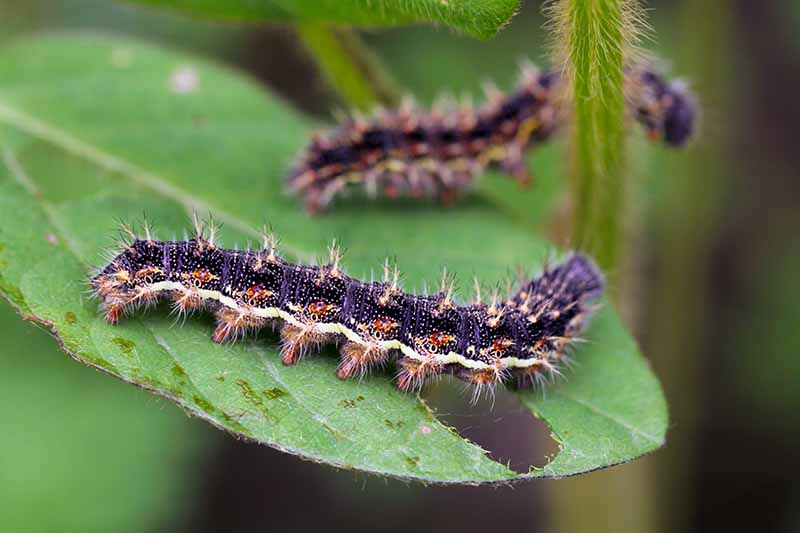
The larvae feed on the leaves, creating irregularly shaped holes, and surround themselves with webbing.
Damage is typically minimal and doesn’t warrant treatment, but it is good to know who is chewing on your precious plants. If these pests do become a problem, control them as you would sunflower moths.
Weevils
There are several different weevils that feed on Helianthus, including the head clipping weevil (Haplorynchites aeneus) and the gray (Smicronyx sordidus) and red seed weevils (S. fulvus).
You’ll know a weevil when you see one. They have long snouts, like an elephant!
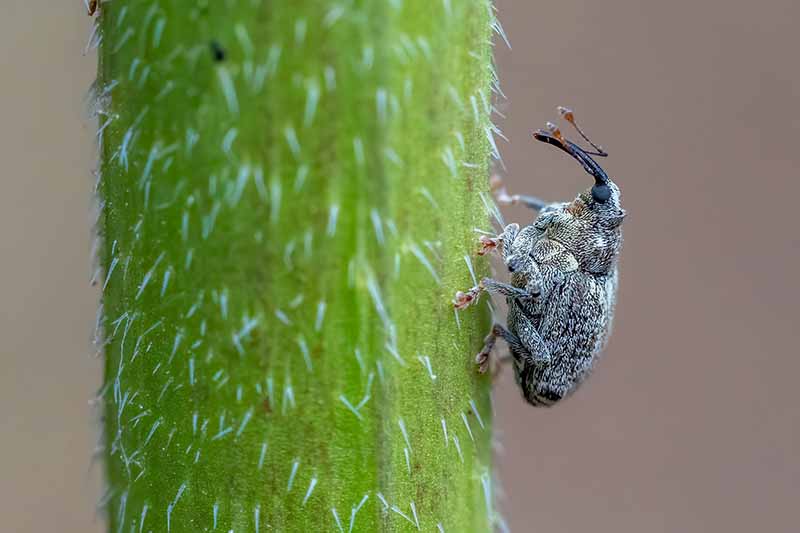
Weevils are pros at playing dead, though, so the adults can be hard to find. Shadows from birds flying over or you rustling through your flower patch can cause them to stiffen and drop off the plant as if they are dead.
The head clipping weevil causes damage you won’t be able to miss. They girdle the flower stem or leaf petioles, leaving partially severed heads and leaves hanging sadly on the plant.
The gray and red seed weevils, each the color of its name, are the most common damaging pests of Helianthus, with the red weevil being the more common of the two. The adults feed on pollen and lay eggs in developing seeds, which the larvae eat once hatched.
The same products that work against sunflower moths will work for weevils. Concentrate application of neem products or insecticidal soaps on the backs of the flower heads. The best time to control sunflower moths and weevils is often overlapping, so you can kill two bugs with one application if both pests are present!
Since weevil larvae drop into the soil to pupate, beneficial nematodes can be very effective in preventing future infestations.
Make sure the product you choose contains the nematode species Heterorhabditis bacteriophora.
NemaSeek Hb Beneficial Nematodes
NemaSeek Hb Beneficial Nematodes is a good option, and it’s available from Arbico Organics.
Wireworms and Darkling Beetles
Species from the wireworm family Elateridae, as well as false wireworms from the family Tenebrionidae, all love a sunflower snack.
Adult wireworms are known as click beetles and they come in various colors. Wireworm larvae have a good sense of smell, and move towards the carbon dioxide scent emitted by germinating seeds. They are white to brown, very slender, and have hard, jointed bodies.
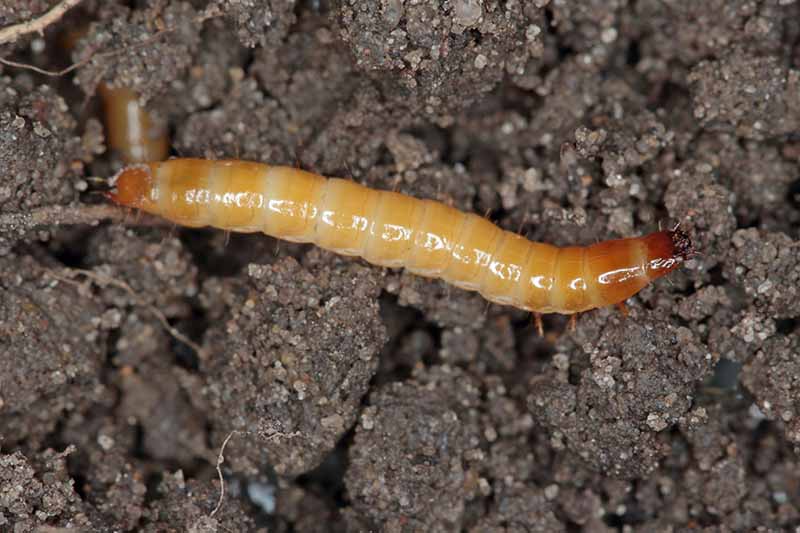
The larvae feed on the underground portions of the plants, including seeds and roots. As a result, the plant will turn yellow and wilt.
False wireworms, or darkling beetles, may also be seen in various colors. Their hard-bodied larvae look very similar to wireworms and come in shiny shades of cream, yellow, or tan. They feed on germinating seeds as well, so it can be hard to tell the difference between the two.
For both types of pests, prevent infestations by removing all plant debris from the garden, and tilling to expose the worms to predators. Let your chickens run loose after tilling, or handpick them yourself and put them in a bucket of soapy water.
If you see evidence of yellowing, it can be difficult to determine if wireworms are the problem. To trap the worms, try this trick:
Cut a potato in half and spear it on a stick. Bury the potato, leaving part of the stick uncovered so you can find it again. A week later, pull it out and see if there are any wireworms feeding on it.
NemAttack Beneficial Nematodes
Try applying beneficial nematodes such as Steinernema carpocapsae, available at Arbico Organics, to control wireworms.
Other Pests
Two other significant and common garden pests that don’t have six legs are birds and squirrels.

Blackbirds, goldfinches, grosbeaks, sparrows, doves, pigeons, and squirrels all love to snack on sunflowers. The high calorie, protein, and fat content of the seeds is attractive to animals that are breeding, storing fat for the winter, or preparing for migration.
Check out our article to learn how to protect sunflowers from birds and hungry squirrels.
No More Snacking on My Sunflowers!
The big, gorgeous, pollen and nectar producing blooms are sure to attract a mix of admiring humans and hungry critters.
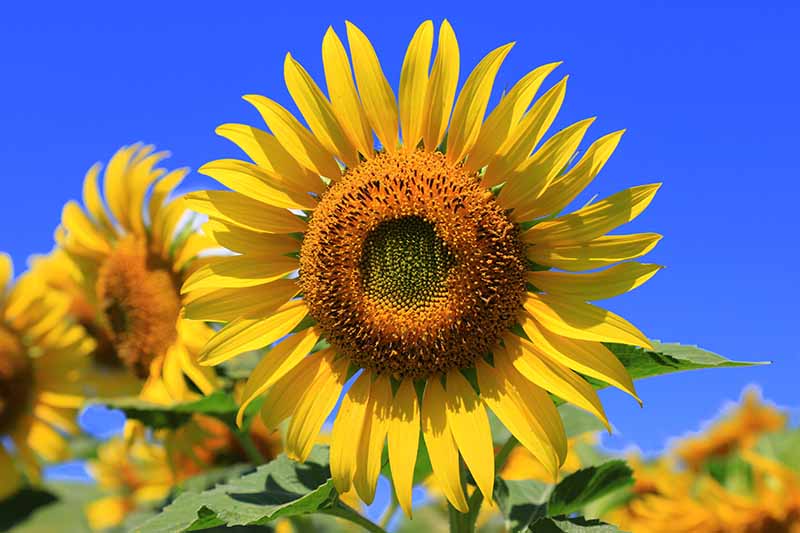
Generally, the small patch or row of sunflowers you grow in your garden won’t see half of these pests, but if they do appear, now you’ve got the know-how to control them!
Have you ever had an insect problem on your Helianthus? Tell us about it and how you dealt with it in the comments below, or feel free to reach out with any questions that we haven’t addressed.
And once you’re done there, check out these articles next to learn more about growing and using sunflowers:
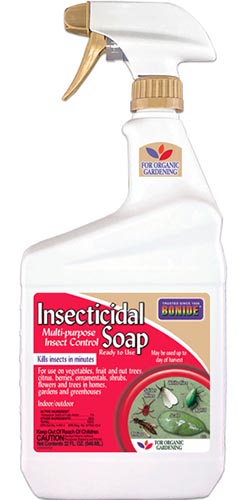


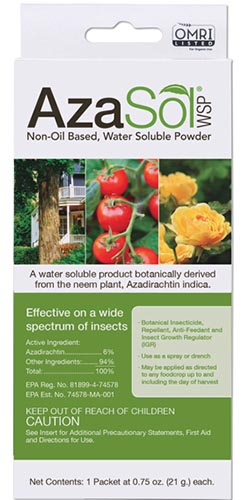
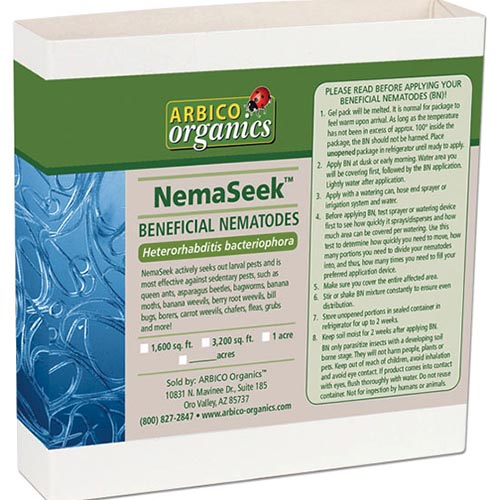

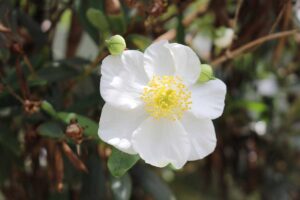

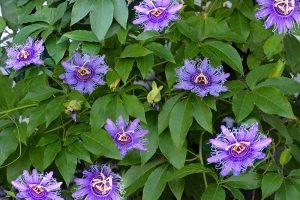
My sunflowers have holes in the leaves
Can you tell me what to get for that?
Hi Susan,
Have you noticed any insects that may be the culprit? Do you have any photos of the holes and/or suspect insects? How bad is the damage?
Hi there,
I just got sunflower 3 days ago and have it indoors. I noticed in 2 days the flower became wilted. Is it normal? And I noticed very small white insects not sure what that is. Can you please advise?
Hello Ksha! Sorry to hear about that wilt. While you can grow sunflowers in containers, it’s pretty tough to keep live plants going indoors without a really good source of sunlight. Is there a chance you could place them outside to see how it goes? Also, it might help to review this coverage of the different reasons that sunflowers droop, and see if any of it might apply to your situation. Last, those bugs could be aphids or scale…they probably won’t hurt the plants much, but you may have a bigger problem with trying to keep a plant alive indoors.… Read more »
Hi, Last year I planted a few different kinds of sunflowers for the first time. I planted them a little late, but they were healthy for the first half of the season. Then when the third or fourth round of blooms came, the heads would all become twisted and wouldn’t open all the way. They were filled with what I assume was frass that completely gummed up the flower face. I am guessing this was moths and/or midges? I did find tiny larvae and tried neem products, but the rest of my blooms were like that for the remainder of… Read more »
Hi Rebecca, Do you have any photos of the heads or the larvae? I’m leaning towards midges as deformed heads with brown, dead tissue that gathers on the edges is typical of midges, and the moths tend to lay their eggs on already open heads. It’s really hard to see the midge adults, and since they lay their eggs in the buds, they are hard to target with any sort of insecticide, plus by the time you noticed them and treated I think it was too late. Cultural strategies are where its at with these guys. The larvae drop from… Read more »
I’ve noticed small titmouse pecking holes in the top leaves of our sunflowers. All that remains of the leaves are their veins! We can’t visually see leaf miners or other pests that they are after. Plus the sunflowers’ seeds haven’t yet formed. Its just the leaves they are after at this time.
Interesting! They must need some greens in their diet 😉
Does anyone know what is happening here, top part of sunflower head? What can i do to protect?
Have you seen a worm in the black spot? Do the affected seeds seem to be rotting? Based on the photo I am not sure if it an insect or disease issue.
Do not see a worm, just little ants crawling around. Sorry I can not tell if they are rotting. Looks like it was eaten. Attached another picture, close up to troubled area.
Ah I see it now. It could be a sunflower moth larvae damage, but without being able to dig around in the seeds or see the insect itself I can’t narrow it down further than that unfortunately.
Thank you for your assistance! I am using Repels-All around the plant and sprayed the plant with Fungicide3. If you have any other suggestion, it would be helpful
First time growing Mammoth Sunflowers.. Thanks again
This sunflower plant was about 5 feet tall, with perfect leaves and a sturdy stalk. Yesterday morning the leaves looked surprisingly wilted. I thought it needed water so I gave it a good drink. By evening the leaves were all completely wilted. The plant was clearly DEAD. I inspected the plant and discovered the bottom 4-5 inches of stalk were eaten away–although the rest of the stalk looked fine. I don’t see any bugs in the dirt or around it. What is going on here? I have a ton of other sunflowers and I don’t want to lose them.
Hi Carol, I’m curious what types of rodents you have in your area? First thing that comes to mind is that something chewed the stem at soil level, causing the sudden girdling and death of your plant. Do you see any teeth marks at all? If it is rodents, try protecting the base of your other sunflowers with wire mesh or some other physical barrier. I hope you don’t lose any more!
The other thing it could be is a basal stalk rot, which, having a closer look at the photo, I’m suspecting it is. Sudden wilting is common with this disease too. The pathogen, S. sclerotiorum, travels through the roots, and nearby plants can get infected too if their roots are touching, and unfortunately unless you have access to fungicides labelled for this disease, it’s gone quite far. My advice would be to pull those immediately surrounding this one to stop possible spread and keep irrigation to a minimum when possible.
Hi Sylvia, I’m wondering if you could possibly help. This was our first year growing sunflowers. We got a bit of a late start but they’re all now fully bloomed, some of them quite large. I cut off the head of the largest and hung it in my kitchen to dry, hoping that in a few weeks we could harvest the seeds. All was well for a day or two, but just now when I went downstairs I saw 3 tiny (maybe 1/4″) dark-colored caterpillars hanging from silk strands from the head. Closer inspection revealed there were even more on… Read more »
Hi Nicole, too bad! It depends on how badly infested the seed is. Are all the heads covered in webs? If it’s just a small infestation you may still end up with some edible seed. Once the seeds are mature and can be removed from the head, check them for larval feeding. The caterpillars will normally eat the entire developing kernel, so it should be obvious which have been affected. You can also freeze the entire thing once the seed is mature/dry to kill the larvae and stop the feeding. Let me know how it goes!
Help!
Whats happening with these plants? No visible insect damage. Planted most seedlings into ground here over 10 days ago and were all doing well up till yesterday and now they’re visibly distressed.
I’ve tried soap and water spray in the morning, but not sure what I’m dealing with. Any suggestions? Thanks in advance!
Hello Betty. So sorry to see these languishing sprouts! My best guess is that they are suffering from damping off, which is caused by a fungus, not an insect pest. It strikes when seedlings get waterlogged or have their leaves soaked from above. If this is the case, you’ll need to start over with new seeds after destroying these seedlings. You may want to replace part of the soil with a sterile mix before you replant. In any case, make sure you’re sowing in sterile soil that is well draining, and keep the area where you sow moist, not wet.… Read more »
Hello, Can anyone tell me why these seedlings have toppled over. They were fine up till yesterday, and have tried soap/water spray. Just unsure of source of pest. Thanks in advance!
Hi Betty! I have addressed your question in the comment above. Thanks for sharing the photo. I hope you can get this situation worked out and are enjoying sunflowers by season’s end.
Thanks for the info, wouldn’t have guessed that because they were healthy plants and doing well. I wasn’t over watering them, but the roots must have gotten too wet at some stage. Thanks again !????
Oh, Betty, I hate the frustration and sadness involved when our carefully tended plants still give up the ghost. I hope you’ve found your way to replanting, but you do have my sympathy.
Things have turned around! Should be on track for flowers by August I think!
Oh Betty this is wonderful news. Thanks for the photos.Way to turn the sunflower situation around!
hello I am seeing little white bugs on top of leaves and black underneath leaves. The plant is kept outside. Should I be concerned or is there something I can spray on the sunflowers? Only second year planting seeds. Last year different kind of sunflowers with no issues.
Can you share photos of the pests, Dawn? And does the black that you’re describing under the leaves appear to be another type of pest, or something else like mold?